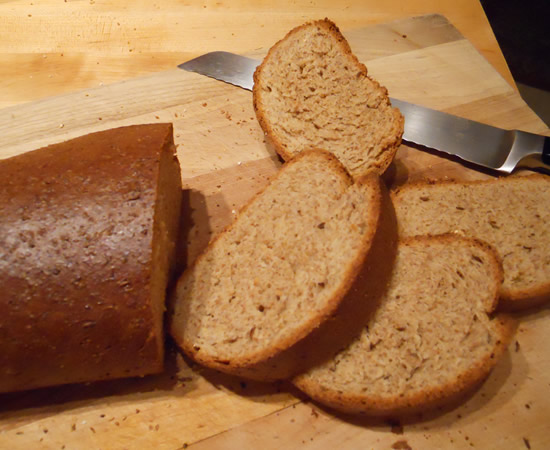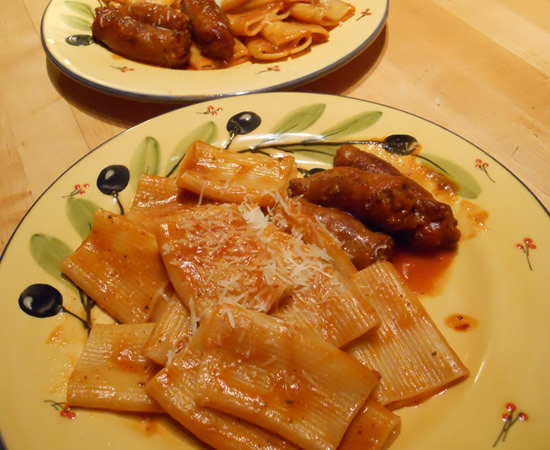The plate is a bit messy but the food was oh, so good!
We’ve had these huge rigatoni in the cabinet for quite a while and tonight, Victor decided we needed use them up and help get the cabinets clear since the flour and sugar has started arriving for Christmas Cookies.
While we cook all the time, this time of year we really start cooking all the time.
Part of it is simply to help warm the house, I think. It’s nice and toasty with the oven and the stove going. But it’s also “the season” for massive amounts of home-cooked goodies.
We have taken a pact that we are seriously cutting back on the cookie production. We were making thousands upon thousands of cookies at one point, buying flour and sugar in 25 pound bags. We have been seriously scaling back for a few years, now, but even as we cut back we find reason to make something new.
Last year it was Springerle cookies and Italian Torrone. I know that between now and Christmas there will be a couple of cookie recipes I just have to make. I’m already working on another variation of the Peppermint Cupcakes. Cutting back. You ought to see us when we just go for it with abandon…
So, to make room in the cabinets for the ingredients for the cookies we’re telling ourselves we’re not going to make, Victor made a fabulous pasta dish.
And we served it with the Rye Bread I made yesterday.
The bread is from James Beard’s Beard on Bread. It is one of the best bread books around. I can bake a loaf of bread in my sleep, but I have a couple of bread books I still reference all of the time. If you pay attention, they are foolproof.
I cut the recipe in half as I just wanted one loaf. It’s really good – and unlike what he says in the beginning, it’s quite easy to make.
James Beard’s Rye Bread
A pleasant rye bread of good texture and interesting flavor. It is rather difficult to make but worth the trouble. This recipe makes two loaves in 8½ × 4½ × 2½-inch pans; or if the dough seems firm enough, it can be baked in one or two free-form loaves, in which case I would suggest letting the formed loaves rise and then very carefully inverting them (right onto hot tiles, if you have them) just before they are baked. This gives a better finished loaf.
Yield : 2 free-form or regular loaves
Ingredients
- 1 package active dry yeast
- 3 tablespoona honey
- ¼ cup warm water (100° to 115°, approximately)
- 1 cup warm milk combined with ½ cup hot water
- 2 tablespoons softened butter
- 1 heaping tablespoon salt
- 1 tablespoon caraway seeds
- 2½ cups rye flour
- 3 cups all-purpose flour, or more if needed
- ¼ cup cornmeal
- 1 egg white, beaten lightly with 2 tablespoons water
Directions
Dissolve the yeast and honey in the warm water, and allow the mixture to proof for 4 or 5 minutes. Combine the warm milk and hot water with the softened butter and add to the yeast mixture along with the salt and caraway seeds. Add the flour, 1 cup at a time, stirring well after each addition. When you have added about 4½ cups the dough will become difficult to stir and will be quite sticky, but continue to add the remaining flour a tablespoon at a time. Scrape out the dough onto a floured board, and using a baker’s scraper or a large metal spatula, scrape under the dough and flour and fold the dough over. Continue to lift and fold, and with your free hand start pressing down and away from you on these folded areas, adding more flour as needed to dust your hands and to sprinkle the board. After 2 or 3 minutes of this procedure you can eliminate the scraper. Flour both hands and knead for about 10 minutes, until the dough is soft, velvety, and elastic.
Shape the dough into a ball and place in a well-buttered bowl, turning to coat with the butter. Cover with plastic wrap and place in a warm, draft-free area to double in bulk, which will take from 1 to 2 hours. Punch down, turn out on a lightly floured board, and divide into two equal pieces. Let the dough rest 2 or 3 minutes, and then shape into two loaves, either free form or for well-buttered 8× 4× 2-inch loaf pans. If you are making free-form loaves allow them to rise, covered, on a buttered baking sheet sprinkled with cornmeal until almost doubled in size, and then quickly invert them and brush with the egg white and water mixture. Otherwise, let the loaves rise, covered, in their pans until they have doubled in bulk and then brush the tops with the egg white and water mixture. Bake at 400° from 45 to 50 minutes or until the loaves sound hollow when tapped with the knuckles. Cool thoroughly on racks before slicing.
I made one single free-form loaf. It came out great.
And now to start thinking about all those cookies we’re not going to make…


